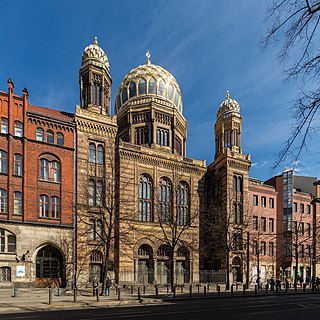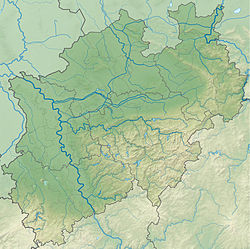
The New Synagogue on Oranienburger Straße in Berlin is a mid-19th century synagogue built as the main place of worship for the city's Jewish community, succeeding the Old Synagogue which the community outgrew. Because of its Moorish style and resemblance to the Alhambra, the New Synagogue is an important architectural monument in Germany.

Roonstrasse Synagogue is an Orthodox Jewish congregation and synagogue, located at 50 Roonstraße in Cologne, Germany. The synagogue is the only surviving of the five synagogues of Cologne before the Nazi era.

The Dohány Street Synagogue, also known as the Great Synagogue or Tabakgasse Synagogue, is a Neolog Jewish congregation and synagogue, located on Dohány Street in Erzsébetváros of Budapest, Hungary. It is the largest synagogue in Europe, seating 3,000 people, and is a centre of Neolog Judaism. The congregation worships in the Ashkenazi rite.

The Frankfurter Judengasse was the Jewish ghetto of Frankfurt and one of the earliest ghettos in Germany. It existed from 1462 until 1811 and was home to Germany's largest Jewish community in early modern times.

The Jewish courtyard in Speyer, is an historic and archeological site located in the inner city of Speyer, Germany. Built in stages between 1104 and the 14th century, the courtyard contains some of the oldest and best-preserved Jewish community buildings. Along with the other ShUM-cities of Worms and Mainz, Speyer was the hometown of one of the most important Jewish communities in Middle Ages in northern Europe. Because of its historical importance and its testimony to the European Jewish cultural tradition, the Jewish courtyard was inscribed on the UNESCO World Heritage List in 2021.
The history of the Jews in Laupheim began in the first half of the 18th century. Until the second half of the 19th century, the Jewish community in Laupheim, expanded continuously to become the largest of its kind in Württemberg. During this period, the Jewish community gradually assimilated to its Christian surroundings and its members prospered until the beginning of the Nazi-period in 1933. With the deportation of the last remaining Jews in 1942, more than 200 years of Jewish history in Laupheim forcibly came to an end.

Congregation Beth Israel is a Reform Jewish congregation and synagogue, located at 1931 NW Flanders Street, Portland, Oregon, in the United States.

The Synagogue in Glockengasse was a Jewish synagogue, that was located in Cologne, in the state of North Rhine-Westphalia, Germany. Designed by Ernst Friedrich Zwirner in the Moorish Revival style, the synagogue was completed in 1861 and destroyed by Nazis on November 9, 1938, during Kristallnacht.

The Worms Synagogue, also known as Rashi Shul, is a Jewish congregation and synagogue located in the northern part of the city center of Worms, in the Rhineland-Palatinate region of Germany.

The New Synagogue is an Orthodox Jewish synagogue, located at Zietenstraße 50, in Düsseldorf, in the Golzheim district of the state of North Rhine-Westphalia, Germany.

The Old Synagogue is a former Jewish congregation and synagogue, located in Erfurt, Thuringia, Germany.

The Selm-Bork Synagogue is a Liberal Jewish congregation and synagogue, located at Hauptstraße 10, in Westphalia, in the Unna district, in the state of North Rhine-Westphalia, Germany. The synagogue is one of two remaining rural synagogues in the region and a witness of pre-Holocaust Jewish life in Westphalia.

The New Synagogue is a former Orthodox Jewish congregation and synagogue, located at 21 Raszkowska Street, in Ostrów Wielkopolski, in the Greater Poland Voivodeship of Poland. Designed by Moritz Landé in the Moorish Revival style and completed in 1860, the former synagogue is located in the city's center, which was the northern edge of the former Jewish district.

Zündorf is a suburb of Cologne, Germany and part of the district of Porz. Zündorf lies on the right bank of the river Rhine, between Langel and Porz. Zündorf has 12.229 inhabitants and covers an area of 8,12 km2.

The Lendava Synagogue is a former Orthodox Jewish congregation and synagogue, located in the small town of Lendava, Slovenia, a town that is close to the Hungarian border. The former congregation was established in 1773 and worshiped in the Ashkenazi rite. The former synagogue was completed in 1866 and was used as a synagogue up until 1944, when the community perished in The Holocaust.

The history of the Jews in Cologne dates to 321 C.E., when they were first recorded in a census decreed by Emperor Constantine I. As such, it is the oldest European Jewish community north of the Alps. The community quickly established itself in what came to be known as Cologne's Jewish quarter, building its first synagogue by 1040 C.E. The Crusades put an end to peaceful coexistence with Christians in 1096 C.E. Despite the Archbishop's protection many Jews were killed and their synagogue destroyed. The community regained its economic and religious life until about 1300 C.E., when the Christian majority again applied pressure. The community's fortunes improved and worsened a number of times into the 20th century. Before the 1930s, it consisted of 19,500 people. After the end of World War II it had been almost entirely extinguished due to Nazi destruction, expulsion and murder. Currently it numbers approximately 5,000.

The history of the Jews in Affaltrach in Obersulm, Germany reaches back to the 17th century and ended during the Holocaust in the 20th century.

The Synagoge Zürich Löwenstrasse is an Orthodox Jewish synagogue, located at Löwenstrasse 10, Zürich, in the Canton of Zürich, Switzerland. Built in 1884 in the Moorish Revival and Byzantine Revival styles, the building is the oldest and largest synagogue in Zürich. The building also houses the prayer and school house of Israelitische Cultusgemeinde Zürich (ICZ) which was founded in 1862. ICZ is a unified Jewish community having about 2,500 members, and thus the largest Jewish community in Switzerland, which since 2007 is recognized as a denomination. In the synagogue, the community celebrates the daily Minyan and Shabbat and holiday services.

The Görlitz Synagogue is a Jewish congregation and synagogue, located on Otto-Müller-Straße, in Görlitz, Germany. Built between 1909 and 1911 in the Art Nouveau style, the synagogue was the main place of worship for the city's Ashkenazi Jewish community. Despite an arson attack, the synagogue was one of the few synagogues in the area to survive Kristallnacht, sustaining only minor damage. The damage was lessened as firefighters ignored the Nazi German orders to let the synagogue burn. With the city's Jewish population depleted, the unused synagogue became a ruin in the following decades.

The Bornplatz Synagogue was a synagogue located in the Grindel district of Hamburg. It was inaugurated in 1906 and was one of the largest synagogues in Germany. It served as the main synagogue of the German-Israelite Community.



















